[ad_1]
Australia’s economy is far from being out of the woods despite a bounce back in GDP figures last quarter, with experts warning that the damage wrought upon the economy by the Covid-19 lockdowns will linger.
The nation has officially emerged from the coronavirus recession with the economy expanding by 3.3 per cent in the September quarter – the strongest quarterly growth in 44 years.
The coronavirus lockdowns and last summer’s bushfires had caused Australia to sink into its first recession – two or more sequential quarters of negative GDP – since 1991.
The return to growth was promising, but economist Martin North of Digital Finance Analytics warned against too much exuberance, saying we are only yet in the foothills of the recovery and major structural problems remain.Â

$25,000 HomeBuilder handouts to stimulate the construction industry have been oversubscribed by 50 per cent leading to a spike in building and trades work
Australians have been cushioned from the full impact of the lockdowns due to the JobKeeper wage subsidies and mortgage repayment holidays, but the bite will be felt when those programs expire.
 ‘Many large firms are off JobKeeper now, but more small firms are still needing support, across retail, entertainment, and leisure industries in particular,’ Mr North told Daily Mail Australia on Sunday.
 ‘At the same time, we have to expect unemployment and underemployment to keep rising for the next year or two. This will keep a lid on household spending and confidence.
‘International borders are likely to remain locked down for some time, so migration and international tourism remains depressed.’Â Â

Consumer confidence has been boosted by unexpectedly low unemployment and a building boom, leading to a surge in consumer spending. Pictured: shoppers in Sydney’s QVB
Mr North said government support for the housing sector and banks had been unprecedented which had lifted the spirits of the real estate industry, however that had negative consequences.
The chance to diversify the economy away from housing construction towards real infrastructure investment had not happened.
‘The high debt incurred by the government and its misdirected spending will be a burden on the recovery,’ he said.Â
 The deflationary impact of the coronavirus has allowed the Federal Government to pursue the same high-debt, low-rate strategy from the last decade.
 ‘I expect rates to stay low for a decade, as we try to navigate our way out – and I am not sure that encouraging people to take more debt on at this time is a responsible stance for Governments to take,’ he said.
Economics professor Steve Keen warned that Australia had de-industrialised over the past 40 years and was now focused on mining and housing.
‘(Australia)Â Â now ranks below Senegal in terms of industrial complexity,’ he told Daily Mail Australia.
‘Building back better, especially in a world with far less international trade than before, will be a long, hard haul.’Â

September quarter figures show economic growth rebounding in Australia’s states and territories except for Victoria, at the end of its covid lockdown, where activity fell 1 per cent
The coronavirus perversely benefited Australia compared with the US, Europe and Canada as a more attractive and virus-free destination, he said, however building back any sort of industrial base after decades of neglect would be extremely hard.Â
Reserve Bank deputy governor Guy Debelle has urged the Federal Government not to withdraw the stimulus packages too early, to avoid a double-dip recession similar to Europe’s.  Â
‘Remove your stimulus at the appropriate pace is obviously a very tautological and possibly somewhat vacuous statement to make, but I do think that it is actually worth thinking about what is the appropriate level of stimulus,’ he told Parliament this week. Â

As interstate borders open, Australians are again taking to the skies. Pent-up consumer demand has been unleashed and consumer confidence is high
 The September quarter GDP figures rose on the back of a spike in housing construction fuelled by government grants and a 7.9 per cent consumer spending surge.
Under the Federal Government’s HomeBuilder scheme designed to protect construction jobs from the pandemic shutdown, eligible Australians can get $25,000 grants for renovations or new home builds. Â
Figures reported by The Australian on Friday showed Australians rushed the taxpayer-funded subsidy, exceeding the initial estimate of 27,000 by January 1.
 It is instead now expected to hit 40,000 by the end of the year, or 50 per cent more than forecast.Â

Reserve Bank of Australia deputy governor Guy Debelle has urged the Federal Government not to remove the coronavirus stimulus too soon or risk a double dip recession like Europe
Industry group Master Builders Australia revealed this week the number of loans to owner-occupiers jumped 11.5 per cent in October, beating the record set in September.Â
It comes as the Australian Bureau of Statistics found new owner-occupier home loans rose 0.8 per cent to $17.4 billion in October 2020 – a more than 30 per cent increase from the same time last year.
Australia’s economy has become heavily reliant on the housing industry, so the construction boost together with an unexpectedly low unemployment rate has boosted consumer confidence.
Consumer spending surged in the September quarter, jumping 7.9 per cent in the as lockdowns eased across Australia.Â
Reserve Bank of Australia governor Philip Lowe said this week that unemployment was now expected to peak between 7 and 8 per cent this year and that the economy has now turned the corner.
This is a much better result than the awful prospect of double-digit unemployment expected earlier this year as the coronavirus pandemic hit and the nation shut down.
Experts feared Australia would be in for the worst economic downturn since the Great Depression, however a raft of government stimulus measures such as $100 billion JobKeeper program kept jobs ticking over during the shutdown.
This avoided long-term damage to the workforce by preventing unemployment from becoming entrenched.Â

Unemployment is unexpectedly low at around 7 per cent – far less than the worst predictions of double-digit joblessness feared at the start of the pandemic
The current jobless rate of 7 per cent is not even as bad as the 11 per cent hit in the 1991 recession. Â
Keeping people employed ensures they have wages with which to pay bills and to buy goods and services, keeping consumer confidence up and creating demand in the economy.Â
Prime Minister Scott Morrison said on Thursday that 2 million people and 450,000 businesses had now ‘graduated’ from JobKeeper.Â
Australia’s banks also helped tide the nation’s borrowers over the lockdown period.
Unlike in the Great Depression of the 1930s when the banks weighed on the recovery, this time their strong balance sheets allowed them to grant $276 billion in loan deferrals for six months.
This allowed struggling households and small businesses to stay afloat until the economy picked back up.
Reserve Bank deputy governor Guy Debelle told a parliamentary committee this week that the financial sector had been able to support the recovery this time around, instead of causing the problems as it had done in the liquidity crunch of 2008.  Â

Australia’s first recession for nearly 30 years. Experts feared it would be worse than the Great Depression. Instead it has ended with a roaring 3.3 per cent growth in the September quarter
Australia’s lockdown recession in response to the pandemic put the nation into unchartered economic territory.
So far, the economy appears to have pulled through – despite the state of Victoria, which represents a quarter of the entire national economy, being in a hard lockdown for months.
Now restrictions are being eased all over the country and as state borders are reopened, pent-up consumer demand is being unleashed.   Â

Australia is following a high-debt low-interest rate strategy made possible by the deflationary environment created by the coronavirus. Australia’s economy may bounce back faster and stronger than anyone predicted. Pictured: The Australian Securities Exchange (ASX) board
If the rebound can be sustained until next year’s vaccine roll-out, the recovery may be stronger and faster than anyone expected.
However, uncertainties persist.
[ad_2]
Source link





